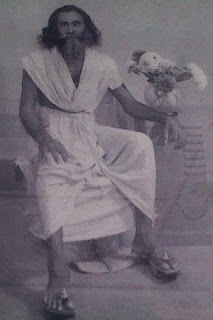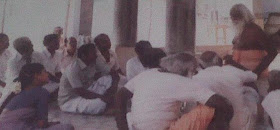Chitramuthu Adigal was born in 1900 in Panaikulam in Ramanathapuram. His mother passed away when he was only eight months old. After his mother died, his father remarried. His grandmother Kumaraiamma brought him up. When she passed away, as he turned six years of age, Chitramuthu was then placed under the care of his paternal aunt Seeniyaayiammal and later his elder sister, Ramaiammal.
Before leaving for Malaya his father placed him under the care of his stepmother Muthunaatchi. His stepmother ill-treated him. She put an end to his schooling in Mudiveeran Pattinam when he was twelve and sent him to work as a toddy tapper in Atthiyutthu.
As he was physically weak due to lack of proper food and rest, one day, he fell while climbing a tree to collect toddy. He fractured his limb. Due to his injury, he was laid off for a year. When he recovered, he went back to grazing the cows and the goats.
When his maternal uncle refused to allow him to marry his (uncle) daughter, Muthu left for Malaya in 1922, staying in Kuala Kangsar, Perak. He worked as a toddy tapper for six years before returning to India in 1928.
He married Alagankulam Sree Kaalaiyappa Nadar’s daughter Shivagami Ammai the following year and they had a child in 1930 who survived only for three days.
He came again to Malaya and stayed in Taiping, Perak. He went back to tapping toddy.
Irusappa Mudaliyar a student of Tenkasi Rangoon Sadagopal Acari introduced him to astrology and he mastered the science.
He met Jeganatha Swamigal in Malaya and Jeganatha Swamigal took him as his disciple and gave him a new name - Chitramuthu. Jeganatha Swamigal helped Chitramuthu realize his true self, his full potential and his mission in life.
Chitramuthu left for India where he had another child whom he named after Jeganatha Swamigal.
He lost his eyesight. Unable to bear it anymore he decided to end his life. That is when he had a vision where an old man handed him a lime. Chitramuthu abandoned the thought of taking his own life. He left for Ramanathapuram hoping to get treatment at the government hospital. At the railway station, one Suppiah Pillai came to his aid and took Chitramuthu to his home. Asking Chitramuthu to wait outside, Suppiah went into his home but never returned. Chitramuthu moved on. A government official took him to a Siddha physician who treated him. After two years in Alagan Kulam, he regained his sight.
He left for Malaya again in 1940. This time he came to spread his teachings. He wore kaavi robes and took on the role of a spiritual teacher.
He had a short stint with the Indian National Army (INA) in Malaya.
 |
| Chitramuthu Adigal |
He left for India in 1947, leaving behind a large following who had regarded him as their guru.
In India, he preached Jeeva Karunya or compassion towards other beings as upheld by Ramalinga Adigal. He opened up his home to the public and named it Aruloli Madam where he started giving discourses. He traveled to the neighboring villagers spreading his message. He managed to convince the public to drop animal sacrifice. Today his village folks (the whole village I am told) have abstained from consuming meat which is a great feat indeed.
He was back in Malaya in 1951. Chitramuthu Adigal preached at the Sree Thandayuthabani temple in Penang, the Aruloli Murugan temple in Penang hill, the Maha Mariamman temple in Ipoh, the Court Hill Pillaiyaar temple in Pudu, the Scott Road Kandaswami temple in Brickfields, the Athi Eswaran temple in Sentul, the Sree Maha Mariamman temple in Jalan Bandar, the Shivan temple in Jalan Sungei Besi, Kuala Lumpur and the Mariamman temple in Singapore.
He stayed in Ceylon in 1953.
Later he left for India. He established many missions in India and Malaya.
 |
| Chitramuthu Adigal in later years |
He authored many songs in Tamil, which were later compiled as a book entitled ARUL OLI. His writing entitled GURUMATHI MAALAI, which dealt with false Gurus, was published amidst much protest and sabotage from certain quarters. Other works of his that saw the light are TIRUPUGAZH TIRAVIYAM, PERINBA KURAL, MOUNANTHA MANI MOZHIGAL, MARANA SINTHANAI, GNANA PANDITHAN, NERAI NERI MOZHIGAL, SEER THIRUNTHU MANITHA, KARUNAI KANNEER, KIRUBAI PIRAGASA POKISHAM, ARULOLI MALAR, and GANDHIYIN THIRUVARUT PULAMBAL.
He established the Atma Shanti Nilayam in Alagan Kulam in 1958. (The Atma Shanti Nilayam became the Thaiveedu where the Deepa Dharisana Tiruvila is celebrated annually on the 7th day in the month of Chitirai, to commemorate the birth of Chitramuthu Adigal.)
The Aruloli Mandram was formed in Malaysia in 1960 under the patronage of Tun V. T Sambanthan, a minister in the Malaysian government. The Malaysian government donated a piece of land in Ipoh where on completion of the building the then Chief Minister of the state of Perak Datuk Sri Haji Kamaruddin Bin Haji Isa officiated its opening of the building on 11 February 1973.
The Aruloli Mandram has since then been established in India, Sri Lanka, Malaysia, Singapore, Australia, and London.
He built and completed his Samadhi Mandabam and had Shivasri Muthu Kumara Sivachariar perform the Kumbhabishegam on the Shivaraja Kopuram in the year 1991.
Chitramuthu Adigal went into Samadhi on Sunday May 5, 1995.
Source of information from Tavayogi Thangarasan Adigal, THIRUPUR THAAIVEEDU AINTHAVATHU ANDU NIRAIVU VIZHA MALAR, 1994, and
http://thaaiveedu.blogspot.com






























